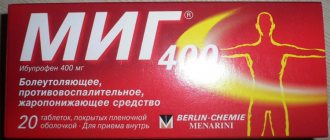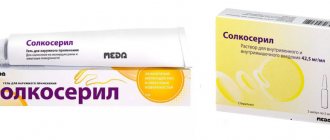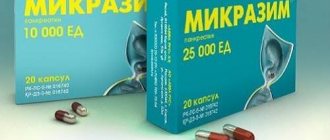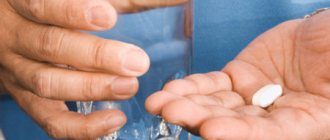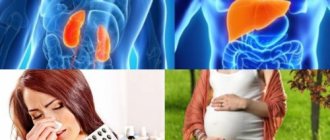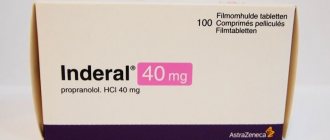Release form
Produced in two medicinal forms. Among them:
- Film-coated tablets. 1 tablet contains 5 mg of levocetirizine dihydrochloride. Additional molecules are silicon microcrystalline cellulose HD90, lactose monohydrate, low-substituted hyprolose, magnesium stearate. Tablets are in a blister of 7 or 10 pieces. In a cardboard package there are 1, 2 or 3 blisters.
- Drops for oral use. 1 flask contains 1 g of medicinal substance. 0.1 ml of solution contains 5 mg of levocetirizine dihydrochloride. Additional molecules are sodium saccharinate, purified water, glacial acetic acid, glycerol, sodium acetate trihydrate.
pharmachologic effect
The active substance is levocetirizine. It has the property of being a highly competitive histamine competitor and blocks H1 histamine receptors. And:
- significantly affects the transport of eosinophils during sensitization with an allergic agent;
- weakens the possibility of penetration of allergens and allergenic complexes by reducing vascular permeability;
- significantly inhibits the production of inflammatory mediators (interleukins, TNF).
Thanks to this, it significantly improves the course of the clinical picture without causing an inhibitory effect on the central nervous system.
The effect occurs 12 minutes - 1 hour after ingestion and lasts 24 hours.
Interaction
Interaction studies of levocetirizine have shown the absence of clinically significant interactions with pseudoephedrine, cimetidine, ketoconazole, erythromycin, and azithromycin. glipizide and diazepam. Combined use with macrolides or ketoconazole did not cause significant changes in the ECG.
Theophylline (at a dose of 400 mg/day) reduces the total clearance of levocetirizine by 16%, while the kinetics of theophylline does not change.
Levocetirizine does not enhance the effects of alcohol, however, in sensitive patients, concomitant use of levocetirizine with alcohol or other CNS depressants may cause CNS effects.
Pharmacokinetics
The drug performs several functions. These include:
- Suction . When administered orally, almost all of the drug enters the systemic circulation, leaving behind inactive metabolites. In adults, the substance in a general therapeutic dose of 5 mg is maximally concentrated in the blood after 90 minutes. After repeated oral administration, the concentration increases by ⅛.
- Distribution . The bioavailability of levocetirizine reaches 100% due to 90% binding to plasma proteins, which contributes to the rapid onset of receptor blocking.
- Metabolism . It is practically not metabolized in the body due to N- and O-dealkyning with the creation of inactive metabolites. This allows it not to bind to other active substances and enhance the action potential.
- Removal . Excreted through glomerular filtration and intestinal secretion. It is not metabolized by the liver due to inactive complexes.
Suprastinex's analogs
Based on the same active substance, the following structural analogues of Suprastinex are distinguished:
- Alerset L is an antiallergic Indian remedy that is not popular due to the presence of a large number of contraindications.
- Allerway is an Indian generic, cheaper than its analogue.
- Glencet - available in tablets, is a generic, produced in India. It costs less than its analogue.
- Zenaro - Czech tablets with an active ingredient for allergies.
- Zodak is a more expensive drug, produced in the Czech Republic, available in tablets.
- Xyzal - Belgian production, tablets and drops, more expensive than its analogue.
- Levocetirizine is a German tablet and is inexpensive. With the Teva prefix - Israeli production, the cost is cheap.
- Cesera - Slovenian production, tablet form only.
- Elcet is a domestic drug, affordable; tablets are produced, packaged from 7 to 90 pieces per pack.
Mechanism of action
Suprastinex, like any other medicine, has its own mechanism of action on the body. A drug:
- penetrating into the body, it quickly blocks antihistamine receptors, and this quantitatively inhibits the migration of eosinophils to the allergen;
- by contacting lymphocytes, it reduces the production of immunoglobulins and the complement system by humoral cells;
- affects the ability of allergens to penetrate the vascular wall, changing the ionic composition of the cell membrane and negatively affecting the transport of allergic agents through active vascular diapedesis;
- influencing histamine receptors, it does not allow the release of inflammatory neurotransmitters and leads to a decrease in the migration of neutrophils, basophils, macrophages, phagocytes and inhibition of activation of the complement system.
What is the difference between Suprastin and Suprastinex?
The name of the drug is similar to another popular remedy in the fight against allergies - Suprastin. The latter is among the first generation of allergy medications, but is not effective. The difference between Suprastin and Suprastinex is a number of negative effects of the former; it can cause drowsiness and lethargy, interfere with coordination and disrupt it, and have a negative effect on the heart. Suprastin contains toxins, the long-term intake of which into the body has a negative effect.
Suprastinex acts faster than Suprastin, its effect lasts for a long time, and regular use is not addictive. It is a modern drug with few side effects. One tablet per day is enough for the patient to remove signs of allergy at any stage. The medication can reduce swelling, itching, and relieve inflammation. It is permissible for them to treat children from two years of age, observing the dosage. You can drink it while taking other medications, since it does not react with the drugs.
Indications
All indications for the use of Suprastinex must be established by the attending physician. Start of use is possible only after identifying convincing evidence for an acute or chronic allergic process.
Indications for starting therapy:
- persistent diseases associated with allergen sensitization for a full year (allergic rhinitis, conjunctivitis);
- intermittent (seasonal) diseases associated with flowering (rhinorrhea, lacrimation, sneezing, itching);
- hay fever;
- skin diseases (urticaria, chronic idiopathic urticaria);
- angioedema;
- allergic inflammation of the dermis with itching, redness, rash.
Indications for use of Suprastinex
Those who want to know why Suprastinex is prescribed can see the list of indications below. In particular, the drug in the form of tablets or drops is prescribed in the following cases:
- Seasonal allergic rhinitis;
- Skin rashes such as eczema, urticaria, contact dermatitis;
- Hay fever;
- Quincke's edema;
- Skin itching due to dermatosis.
Contraindications
Contraindications to drug therapy:
- individual hypersensitivity and intolerance to the active substance and/or one of the additional substances, including piperazine;
- children under 2 years of age in liquid form and children under 6 years of age in tablet form due to the lack of large randomized studies;
- pregnancy and natural feeding;
- for the hard form - lactose intolerance and malabsorption syndrome of glucose-galactose in the intestine;
- chronic kidney disease resulting in chronic renal failure with a GFR level of less than 10 ml/min.
May be taken with caution:
- elderly people due to a decrease in GFR;
- biological and traumatic spinal cord and cerebral coma;
- a condition threatening possible urinary retention (chronic prostatitis, cancer of the bladder, prostate, cervical canal);
- severe renal failure (careful selection of dosage is necessary based on the conditions of glomerular filtration rate).
Contraindications and side effects
- The drug is not prescribed to children under two years of age, as well as to those with hypersensitivity to Levocetirizine or an auxiliary component of the drug.
- Suprastinex should be taken during pregnancy (especially in the first and third trimester) only if the potential benefit to the pregnant woman outweighs the risk to the fetus, since no studies have been conducted on the effect of the drug on pregnant women. If it is necessary to use the drug during lactation, breastfeeding should be suspended.
- The drug should be taken with caution if the liver and/or kidney function is impaired, as well as in old age.
Possible side effects in the form of headache, dizziness, increased fatigue, dry mouth, abdominal pain, nausea.
Instructions for use
Swallow whole at the time of eating with a sufficient amount of liquid. The solid form is not chewable due to a likely decrease in bioavailability.
When using the liquid form, you need to use a teaspoon.
It can be diluted in a small amount of boiled water to facilitate oral use.
The daily dose should be used simultaneously to quickly increase the dose in the systemic circulation.
- The required dose for the working population, elderly people (with moderate renal function) and children over 6 years of age is tablet form 5 mg (1 tablet), solution - 1 ml (20 drops ). Increasing the dose is prohibited due to the potential for adverse effects;
- Children age 2 to 6 years - 5 mg (10 drops) per day . The daily dose should be divided into two doses of 1.25 mg. Exceeding this dose may cause side effects.
The possibility of using the drug in people with diseases of the renal system and a decrease in filtration capacity should be determined based on the level of GFR:
- GFR from 30 ml/min - the total daily dose must be reduced by 2 times;
- GFR from 10 to 29 ml/min - the main dose should be reduced by 3 times;
- GFR up to 10 ml/min - use is strictly contraindicated.
In patients with a disorder of the biliary system, dosing of the drug is not necessary due to the lack of hepatic metabolism.
Drops for oral administration Suprastinex (Suprastinex)
Instructions for medical use of the drug
Indications for use
Symptomatic treatment of the following conditions: year-round (persistent) and seasonal allergic rhinitis and conjunctivitis (itching, sneezing, rhinorrhea, lacrimation, conjunctival hyperemia); hay fever (hay fever); urticaria, incl. chronic idiopathic urticaria; Quincke's edema; allergic dermatosis, accompanied by itching and rashes.
Release form
drops for oral administration 5 mg/ml; dark glass bottle (bottle) with a PE dropper 20 ml, cardboard pack 1.
Pharmacodynamics
Enantiomer of cetirizine; competitive histamine antagonist; blocks H1-histamine receptors, the affinity for which is 2 times higher than that of cetirizine. Affects the histamine-dependent stage of allergic reactions; reduces the migration of eosinophils, reduces vascular permeability, limits the release of inflammatory mediators. Prevents the development and facilitates the course of allergic reactions, has an antiexudative and antipruritic effect; has virtually no anticholinergic and antiserotonergic effects. In therapeutic doses it has virtually no sedative effect. The action begins 12 minutes after taking a single dose in 50% of patients, after 1 hour in 95%, and continues for 24 hours.
Pharmacokinetics
Pharmacokinetics is linear. Rapidly absorbed when taken orally; food intake does not affect the completeness of absorption, but reduces its speed. Bioavailability - 100%. Tmax - about 0.9 hours; Cmax - 207 ng/ml. Vd - about 0.4 l/kg. Plasma protein binding - 90%. Less than 14% of the drug is metabolized in the liver by O-dealkylation to form a pharmacologically inactive metabolite. T1/2 - 7–10 hours. Total Cl - about 0.63 ml/min/kg. Completely excreted from the body within 96 hours. Excreted by the kidneys (approximately 85.4%). In case of renal failure (Cl creatinine less than 40 ml/min), clearance is reduced (in patients on hemodialysis by 80%), T1/2 is prolonged. Less than 10% is removed during hemodialysis. Passes into breast milk.
Use during pregnancy
Animal studies have shown no direct or indirect harmful effects on pregnancy, embryonic or fetal development, childbirth or postnatal development. There have been no controlled clinical studies on the safety of the drug in pregnant women, so the drug should not be prescribed during pregnancy. Levocetirizine is excreted in breast milk, so if it is necessary to take it during lactation, breastfeeding should be stopped while taking the drug.
Contraindications for use
- hypersensitivity to the active substance (including piperazine derivatives) or any auxiliary component of the drug; - severe renal failure (creatinine Cl less than 10 ml/min); - children under 6 years of age (for film-coated tablets) and up to 2 years (for oral drops); — pregnancy and lactation (see section “Use during pregnancy and lactation”); - lactose intolerance, hereditary Sami lactase deficiency or glucose-galactose malabsorption syndrome - for film-coated tablets (see section "Special instructions"). With caution: chronic renal failure, old age (possibly decreased glomerular filtration).
Side effects
The parameters used below for the frequency of side effects are defined as follows: very often - ≥1/10; often - ≥1/100 and From the immune system: very rarely - allergies, incl. anaphylaxis. Metabolic: very rarely - weight gain. From the central and peripheral nervous system: often - drowsiness, headache, increased fatigue; infrequently - asthenia; rarely - migraine, dizziness. From the respiratory system: very rarely - dyspnea. From the gastrointestinal tract: often - dry mouth; infrequently - abdominal pain; very rarely - nausea, dyspepsia. From the subcutaneous fat: very rarely - angioedema, itching, rash, urticaria. From laboratory parameters: very rarely - changes in liver function tests.
Directions for use and doses
Inside, during meals or on an empty stomach, with a small amount of water, without chewing. Drops are measured using a dropper into a tablespoon or glass of water and should be taken immediately after dilution. It is recommended to take the daily dose at one time. The recommended dose for adults and children over 6 years of age, elderly patients (provided normal kidney function) is 5 mg (1 tablet or 1 ml (20 drops) per day; children aged 2 to 6 years - 2.5 mg per day 2 doses in equal doses of 1.25 mg (2 times 0.25 ml drops or 2 times 5 drops) Patients with impaired renal function. The frequency of administration should be determined individually in accordance with renal function. In patients with chronic renal failure with Cl creatinine from 30 to 49 ml/min, the dose must be reduced by 2 times - 5 mg (1 tablet or 1 ml (20 drops) every other day; with creatinine Cl from 10 to 29 ml/min, the dose must be reduced by 3 times - 5 mg (1 tablet or 1 ml (20 drops) every 3 days. In severe renal failure (creatinine clearance less than 10 ml/min), the drug is contraindicated. Patients with impaired liver function. When prescribing the drug to patients with isolated impaired function liver, no dose changes are required. In patients with concomitant impairment of liver and kidney function, dose adjustment is recommended (see. See “Patients with Impaired Renal Function” section above). Duration of taking the drug. The duration of treatment depends on the disease. The average course of treatment for hay fever is 1–6 weeks. For chronic diseases (year-round rhinitis, chronic idiopathic urticaria), the course of treatment may be increased. There is clinical experience with the use of the drug for up to 18 months.
Overdose
Symptoms: in adults they manifest as drowsiness, in children - agitation, anxiety, which are replaced by drowsiness. Treatment: symptomatic and supportive therapy, gastric lavage, administration of activated charcoal. Hemodialysis is ineffective. There is no specific antidote.
Interactions with other drugs
Interaction studies of levocetirizine have shown the absence of clinically significant interactions with pseudoephedrine, cimetidine, ketoconazole, erythromycin, and azithromycin. glipizide and diazepam. Combined use with macrolides or ketoconazole did not cause significant changes in the ECG. Theophylline (at a dose of 400 mg/day) reduces the total clearance of levocetirizine by 16%, while the kinetics of theophylline does not change. Levocetirizine does not enhance the effects of alcohol, however, in sensitive patients, concomitant use of levocetirizine with alcohol or other CNS depressants may cause CNS effects.
Special instructions for use
During the treatment period, it is recommended to refrain from drinking ethanol (see section “Interaction”). Suprastinex® film-coated tablets contain lactose and should not be administered to patients with lactose intolerance, hereditary Sami lactase deficiency or glucose-galactose malabsorption syndrome. Suprastinex® drops for oral administration are not recommended for use in children under 2 years of age (due to insufficient data on the use of the drug). Drops can cause allergic reactions (sometimes late), because contain methyl and propyl parahydroxybenzoate. Influence on the ability to drive vehicles and operate machinery. During the treatment period, it is recommended to refrain from engaging in potentially hazardous activities that require increased concentration and speed of psychomotor reactions.
Storage conditions
At a temperature not exceeding 25 °C (do not freeze). Store an open bottle for no more than 4 weeks.
Best before date
36 months
ATX classification:
R Respiratory system
R06 Antihistamines for systemic use
R06A Antihistamines for systemic use
R06AE Piperazine derivatives
R06AE08 Levocetirizine
Overdose
An overdose of a dosage form occurs when the recommended dose is systematically exceeded and manifests itself in the form of:
- in adults - drowsiness, confusion, nausea, vomiting, dizziness, disorientation.
- in children - excitability of the psycho-emotional background, anxiety, quickly giving way to drowsiness, mental lability.
There is no antidote to the molecule. If drug poisoning is suspected, it is necessary to immediately stop oral use and empty the stomach by lavage.
These measures should only be taken if a short period of time has passed since the last use. Consult your doctor immediately.
The main therapy is aimed at the emerging symptoms and the fight against general intoxication syndrome. Hemodialysis is ineffective.
Pharmacological properties
Under the influence of the main compound, the release of mediators of the inflammatory process is blocked due to a direct effect on the histamine-dependent stage of most allergic reactions. As a result, there is a gradual elimination of any manifestations of allergic diseases.
Suprastinex has been noted to be highly effective in the treatment of dermatoses, hay fever, and chronic idiopathic urticaria.
- The drug has an active anti-edematous effect, thereby facilitating the patient’s breathing during an attack.
- Thanks to Suprastinex, vascular permeability decreases, as a result of which the frequency of allergic reactions decreases.
- Additionally, the medicinal drug helps eliminate redness and itching during conjunctivitis, and relieves its other unpleasant symptoms.
Bioavailability is estimated to be almost 100%. After use, the medicine quickly undergoes the process of absorption in the gastrointestinal tract, then is metabolized in the liver and enters the general bloodstream.
special instructions
Special instructions include the following:
- for the period of treatment, complete abstinence from ethanol and its derivatives is required;
- refusal of use by persons with lactulose intolerance due to its content in the composition;
- a complete ban on persons with traumatic and/or biological damage to the central nervous system and persons with the possible development of acute urinary retention;
- abstinence from work requiring increased psycho-emotional stress (driving vehicles, working at heights, servicing mechanized machines in production).
Only as prescribed by a doctor, you can use other drugs in combination:
Why is the drug prescribed?
According to the instructions for use, antihistamine drops can be prescribed by a specialist for the symptomatic treatment of the following conditions:
- seasonal or persistent rhinitis, conjunctivitis of an allergic nature (swelling, increased mucus formation in the nasopharynx, severe itching);
- Chronic urticaria (including the idiopathic variety)
- hay fever of various types;
- allergic dermatosis, which is accompanied by rash and itching;
Despite the fact that the active component of the medicine is a modern antihistamine, it should be used only after consultation with your doctor.
Patients' opinions about the drug
Patient reviews of the drug Suprastinex:
For many years I have suffered from a runny nose, and it does not give me life. I’m waiting for spring as if it were heavenly punishment, because flowering will begin and I won’t be able to breathe. But my doctor prescribed Suprastinex, and I began to live a new life. My nose breathes, and I’m not afraid to go outside. I'm very happy.
Anna, 34 years old
Basically I always sneeze and tears flow. I work in paper production and before I got a job there, everything was fine. I don't want to lose my job and started using this miracle drug. I no longer think about changing jobs, since my nose is breathing, there is no more sneezing.
Sergey, 26 years old
I like that you only have to take it once a day. I have become forgetful and this is acceptable to me.
Nikolai Petrovich, 72 years old
Similar drugs:
- Ergoferon () Lozenges
- Celandine grass (Chelidonii majoris herba) Vegetable raw materials
- L-cet Oral tablets
- Loratadine Syrup
- Peritol Oral tablets
- Loratadine-Teva Oral tablets
- Erespal Oral tablets
- Levocetirizine-Teva Oral tablets
- Aminazine Dragee
- Lordestin Oral tablets
** The Drug Directory is intended for informational purposes only. For more complete information, please refer to the manufacturer's instructions. Do not self-medicate; Before starting to use the drug Suprastinex, you should consult a doctor. EUROLAB is not responsible for the consequences caused by the use of information posted on the portal. Any information on the site does not replace medical advice and cannot serve as a guarantee of the positive effect of the drug.
Are you interested in the drug Suprastinex? Do you want to know more detailed information or do you need a doctor's examination? Or do you need an inspection? You can make an appointment with a doctor - the Euro lab is always at your service! The best doctors will examine you, advise you, provide the necessary assistance and make a diagnosis. You can also call a doctor at home . Euro lab clinic is open for you around the clock.
** Attention! The information presented in this medication guide is intended for medical professionals and should not be used as a basis for self-medication. The description of the drug Suprastinex is provided for informational purposes and is not intended for prescribing treatment without the participation of a doctor. Patients need to consult a specialist!
If you are interested in any other drugs and medications, their descriptions and instructions for use, information about the composition and form of release, indications for use and side effects, methods of use, prices and reviews of drugs, or you have any other questions and suggestions - write to us, we will definitely try to help you.
Doctors' opinions about the drug
Reviews from doctors about the drug Suprastinex:
In my practice, Suprastinex appeared several years ago and immediately proved its superiority over other treatment units. For a long time, people took standard antihistamines, and the effect was not impressive. But everything changed after the arrival of this drug. The patients are happy and I am happy.
Anton, general practitioner
Nowadays, the complexity of treating allergies depends on a large number of different substances, most of them of questionable quality. But Suprastinex stands out qualitatively from their background. My patients walked for years and suffered from runny noses, sneezing, and tears. They could not live and work normally. After starting the treatment, the effect comes quickly and I can monitor their condition by stopping the drug in time. Very convenient, I'm very pleased.
Andrey, allergist
Simplicity, effectiveness and accessibility for my patients. What could be better?
Valery, general practitioner
Reviews of Suprastinex
Judging by the available reviews, Suprastinex is not a very popular antihistamine. In their reviews, users speak positively about the drug when used as part of complex therapy for infectious and inflammatory diseases, which are accompanied by manifestations of various forms of allergic reactions.
In most cases, reviews of Suprastinex in the form of drops are positive. The medicine exhibits a high degree of effectiveness and allows not only to alleviate the patient’s condition, but also to eliminate allergic manifestations.
Patient review
Patients who have taken the drug characterize it as an effective remedy in the treatment of allergies, effectively and quickly relieving its symptoms.
The disadvantages of the drug include the development of side effects, mainly in the form of drowsiness and increased fatigue. Also, some patients express dissatisfaction with the price of the drug and the short shelf life of drops in an open bottle.
Advantages and disadvantages
The drug has its positive and negative sides.
Pros:
- Once daily use increases treatment adherence and ease of use;
- rapid onset of action;
- availability in pharmacies;
- proven effectiveness.
Minuses:
- often causes drowsiness, and this greatly interferes with everyday life;
- high risk of overdose and adverse reactions;
- inability to simultaneously use and feed breast milk.
Suprastinex
Active substance:
Levocetirizine*
Pharmgroup:
H1.antihistamines
Average price in pharmacies
| Name | Manufacturer | average price |
| Suprastinex 0.005 n14 tablet p/capt/coating | Egis Pharmaceutical Plant CJSC | 404.00 |
| Suprastinex 0.005 n7 tablet p/capt/coating | Egis Pharmaceutical Plant CJSC | 251.00 |
| Suprastinex 0.005/ml 20ml bottle drops | Egis Pharmaceutical Plant CJSC | 322.00 |
Analogs for the active substance:Glenzeth Xizal Caeser | Application area:Allergic rhinopathy Allergic rhinosinusopathy Allergic eye diseases Allergic diseases of the upper respiratory tract Allergic respiratory diseases Allergic skin diseases Allergic skin diseases of non-infectious etiology Allergic skin diseases of non-microbial etiology Allergic skin diseases Allergic conjunctivitis Allergic skin lesions Allergic manifestations on the skin Allergic dermatitis Allergic dermatosis Allergic diathesis Allergic pruritic dermatosis Allergic conjunctivitis Allergic conjunctivitis caused by chemical and physical factors Allergic runny nose Allergic edema Allergic rhinitis Allergic rhinitis seasonal Allergic rhinoconjunctivitis Allergic eye inflammation Allergic skin disease Allergic skin irritation Vasomotor rhinitis Spring Qatar Spring keratitis Spring conjunctivitis Viral rhinitis Inflammation of the nasopharynx Inflammatory disease of the nose Severe itching Hypersensitivity to pollen Purulent rhinitis Allergic dermatitis Atopic dermatitis Allergic dermatosis Exudative diathesis Long-term allergic rhinitis Nasal congestion Nasal congestion due to colds and flu Difficulty in nasal breathing Difficulty in nasal breathing due to colds Difficulty in nasal breathing Difficulty in nasal breathing due to colds Itching of the scalp Itchy atopic eczema Itchy eczema Pruritic allergic dermatosis Idiopathic urticaria Idiopathic chronic urticaria Insect urticaria Infectious and inflammatory disease of ENT organs Skin allergic disease Skin allergic reaction to drugs and chemicals Skin reaction to medications Skin allergic disease Skin itching due to venous insufficiency Allergic conjunctivitis Newborn urticaria Year-round allergic rhinitis Year-round allergic conjunctivitis Year-round allergic rhinitis Year-round or seasonal allergic rhinitis Year-round rhinitis of allergic nature Laryngeal exacerbation with angioedema Hay fever Nasal hypersecretion Runny nose Runny nose, vasomotor allergic Nonseborrheic dermatitis Exacerbation of hay fever in the form of rhinoconjunctival syndrome Exacerbation of hay fever in the form of rhinoconjunctival syndrome Acute respiratory infection with symptoms of rhinitis Acute eczema Acute allergic keratoconjunctivitis Acute allergic conjunctivitis Acute allergic rhinitis Acute rhinitis Acute rhinitis of various origins Acute rhinitis with thick purulent-mucous exudate Acute nasopharyngitis Quincke's edema Swelling of the nasal mucosa Swelling of the nasal mucosa Swelling of the nasopharyngeal mucosa Swelling of the nasal mucosa Swelling of the nasal mucosa Swelling of the nasal mucosa Superficial bacterial eye infection Polypous allergic rhinosinusitis Hay fever Persistent allergic rhinitis Prurith Common neurodermatitis Recurrent angioedema Recurrent angioedema Rhinitis Rhinoconjunctivitis Rhinoconjunctivitis Rhinorrhea Rhinosinusitis |

